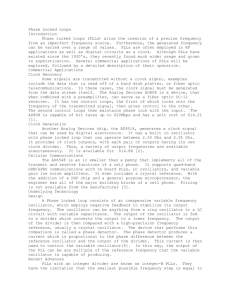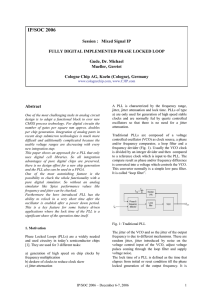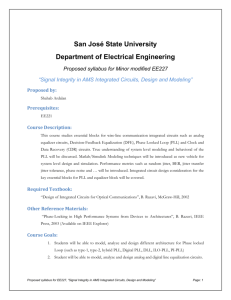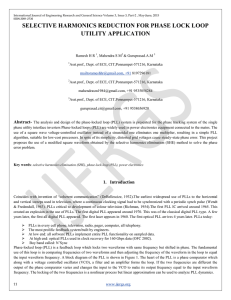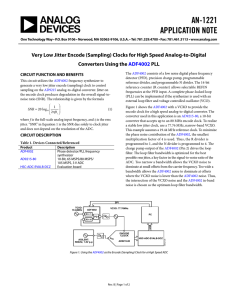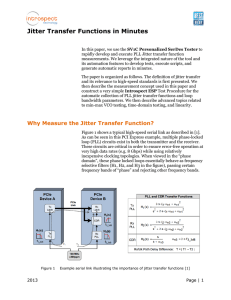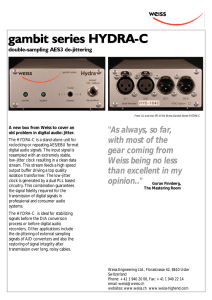selvar_DPLL
advertisement
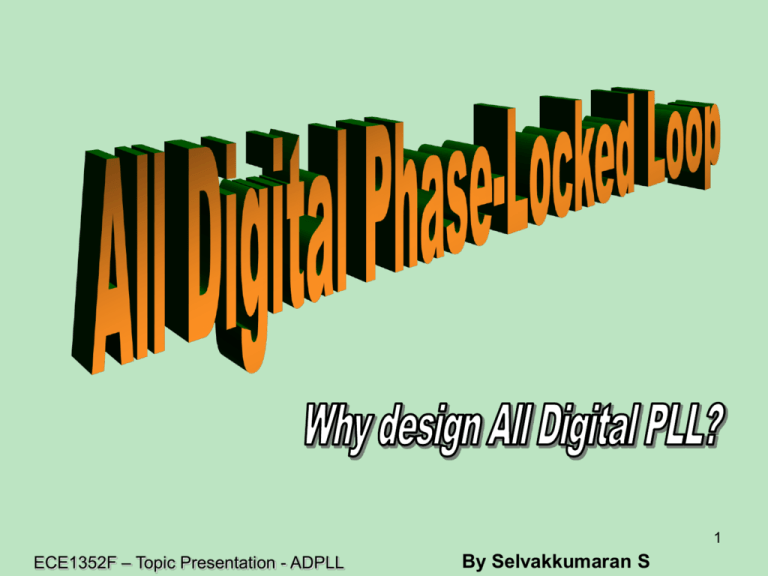
1 ECE1352F – Topic Presentation - ADPLL By Selvakkumaran S • Some Analog PLLs have utilized pure digital components before e.g: Charge-pump PLLs utilized Phase Frequency Detector consisting of 3-state finite state machine with two flip-flops Up D A Q CK B CK D Q Dn 2 ECE1352F – Topic Presentation - ADPLL fin Digital Phase Detector Digital Loop Filter fout Digital VCO • All Digital PLLs consist only of digital components • The first All Digital PLL was reported by Drogni [1967] ECE1352F – Topic Presentation - ADPLL 3 Why All Digital PLL? Improvements in digital designs *Progress in increasing *Progress in reducing • Performance • Size • Speed • Cost • Reliability * Portability/ Reusability * Programmability * Testability ECE1352F – Topic Presentation - ADPLL 4 Why All Digital PLL? Solves Problems Related to Analog PLLs(APLL) • • • • Sensitivity to DC Drifts Component Saturations Difficulties building higher order loops Initial calibration and periodic adjustments 5 ECE1352F – Topic Presentation - ADPLL Issues of ADPLLs versus APLLs • Limitation on operating speed • Chip area • Power Consumption • Worse jitter performance due to D/A converter resolution limitation * Note: The above issues need further exploration[7] as some papers have reported better ADPLL performance. 6 ECE1352F – Topic Presentation - ADPLL Example ADPLL Loop Filter • Up/Down control from the Phase Detector Controls the Counter value or the Digital Phase difference – Transfer Function ~ 1/sTi Up/Down Counter 7 ECE1352F – Topic Presentation - ADPLL Example Digital VCO (DCO) • Up/Down Counter Value or the Phase Error is utilized to create the clock %N Counter 8 ECE1352F – Topic Presentation - ADPLL ADPLL Design Analysis Z-transform technique [5,6] • z domain transfer function • Solutions within the unit circle ensures stability 9 ECE1352F – Topic Presentation - ADPLL ADPLL Design Example 1[2] 10 ECE1352F – Topic Presentation - ADPLL 3.3V Supply Process Results [2] 0.35m 0.25m Approach AD Cell Based 0.60m Analog Semi(1.9V) digital 0.60m 0.50m AD Cell Based AllDigital Area(mm2) 0.71 0.09 0.83 2.75 0.71 Power(mW) 100 25 105 315 39.6 @400MHz @800MHz @100MHz <16 <25 <50 @500MHz Max.lock <46 Time(cycles) <720 Range MHz 45-510 8.5-660 300-800 360-800 50-550 Output Jitter 70ps 149ps 80ps 60ps 125ps 11 Results[2] • • • • • • Shorter Locking in time Better Jitter Performance Better Portability (cell-based design) Reduced circuit complexity Reduced Design Time Note: Some other papers have reported ADPLLs area and power statistics better than APLLs 12 ECE1352F – Topic Presentation - ADPLL ADPLL Design Example 2[6] A Second order ADPLL H(z)= C2(Z-1)+C1 (Z-1)2+C2(Z-1)+C1 H(S)= 2hwnS + wn2 S2 + 2hwnS + wn2 13 ECE1352F – Topic Presentation - ADPLL Acquisition Behaviour[6] *ADPLL shows a better performance in terms of the acquisition time 14 ECE1352F – Topic Presentation - ADPLL Phase Jitter Behaviour[6] 15 ECE1352F – Topic Presentation - ADPLL Results[6] • • • • • Larger lock-in range (~4.5 x APLL) Larger Hold-in Range than APLL Smaller RMS Phase Jitter Digital approach to design Software configurability/ programmability 16 ECE1352F – Topic Presentation - ADPLL • • • • • • • • • • Stability Fast Acquisition Time Large hold-in range Large lock-in range Better phase jitter performance No need for off-chip components Technology portability Testability Programmability Simpler design and faster simulation 17 ECE1352F – Topic Presentation - ADPLL Future of ADPLL • Digital IP (Intellectual Property) vendors are already creating ADPLL products • As technology progress happens skew problems will require ADPLLs within the design components to synchronize the clock signal between various blocks 18 ECE1352F – Topic Presentation - ADPLL 1. Behzad Razavi, Design of Analog CMOS Integrated Circuits, McGraw-Hill, 2001 2. Ching-Che Chung and Chen-Yi Lee, “An All-Digital PhaseLocked Loop for High Speed Clock Generation, IEEE J. SolidState Circuits, vol 38, No.2, pp347-351, February 2003 3. Thomas Olsson and Peter Nilsson, “A Digitally Controlled PLL Using a Standard Cell Library”, Lund University, Sweden, www.es.lth.se/home/ton 4. Roland E. Best, Phase-Locked Loops, Design, Simulation and Applications, 4th Ed, McGraw-Hill, 1999 (Chapter 4, pp177228) 5. Venceslav F, Kroupa, Phase Lock Loops and Frequency Synthesis, Wiley, 2003, (Chapter 10, pp231-254) 19 ECE1352F – Topic Presentation - ADPLL 6. 7. Y.R.Shayan, T.Le-Ngoc, “All Digital phase-locked loop: concepts, design and applications”, IEE Procedings, Vol.136, Pt. F. No.1, pp53-56, February 1989 Dao-Long Chen, “A Power and Area Efficient CMOS Clock/Data Recovery Circuit for High-Speed Serial Interfaces, IEEE J. of Solid-state Circuits, Vol. 31, No8, pp1170-1176, August 1996 20 ECE1352F – Topic Presentation - ADPLL 21

